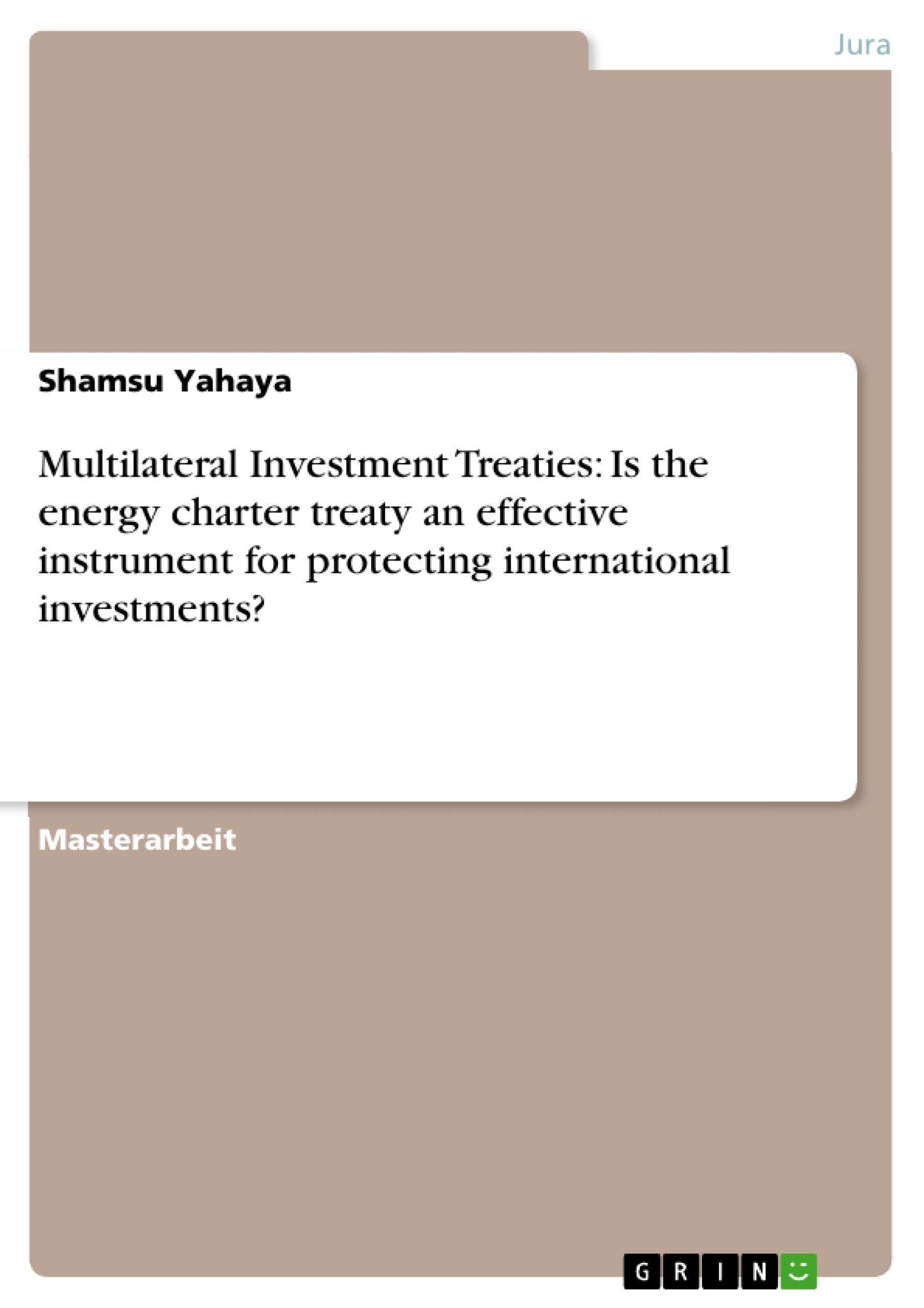The end of the cold war signalled an emerging need for economic integration between Western European countries and those countries which comprised the former Soviet Union. The energy sector was considered a perfect starting point for pursuing such cooperation mainly due to the fact that Eastern European countries were considered rich in oil and gas reserves. For this purpose, the Energy Charter Treaty as well as the Energy Charter Protocol were signed in December 1994 and came into effect on 16th April, 1998. The aim of the Treaty was to establish a comprehensive legal framework for promoting long-term cooperation between signatory countries in the energy sector. Indeed, the treaty is considered a powerful tool for investors as it grants direct right to initiate arbitration proceedings against host governments where there are alleged breaches of investment obligations. The purpose of this dissertation is to take a critical look at the effectiveness or otherwise of the treaty as regards the protection of international investments in the energy sector. A historical background leading up to the signing of the charter will be rendered. Also, the provisions of the treaty regarding investment protection and arbitration taking certain case studies of causes of action brought under the treaty will be discussed. Furthermore, a critical look at the shortcomings of the treaty will be attempted. The research findings will show that several successful cases have been concluded under the treaty; but criticisms and limits to the effectiveness of the treaty will be highlighted.
Inhaltsverzeichnis
- INTRODUCTION AND HISTORICAL BACKGROUND
- INTRODUCTION
- Historical Background
- Summary
- INVESTMENT PROTECTION REGIME IN THE ECT
- Introduction
- What is an investment in the Treaty?
- Who is an investor in the Treaty?
- Limits to protection of investments and investors
- Investment protection provisions
- Summary
- ARBITRATION PROVISIONS IN THE ECT
- Introduction
- Dispute settlement mechanisms in the ECT
- The investment arbitration mechanism
- Summary
- INVESTMENT DISPUTES UNDER THE ECT
- Introduction
- NYKOMB SYNERGIES v. THE REPUBLIC OF LATVIA
- Plama Consortium Limited v. The Republic of Bulgaria
- Petrobart Limited v. Kyrgyz Republic
- Alstom Power Italia SpA and Alstom SpA v. Mongolia
- Yukos v. The Russian Federation
- Summary
- CRITICAL EVALUATION OF THE INVESTMENT PROTECTION AND DISPUTE SETTLEMENT MECHANISMS UNDER THE ECT
- Introduction
- Critique of applicable law
- Critique of definition of investors and investments
- Fork in the Road?
- The Russian Perspective
- Summary
Zielsetzung und Themenschwerpunkte
Diese Dissertation befasst sich mit der Wirksamkeit des Energiecharta-Vertrags (ECT) als Instrument zum Schutz internationaler Investitionen. Der Fokus liegt auf der Analyse des Investitionsschutzregimes und der Streitbeilegungsmechanismen im ECT, einschließlich der Bewertung der einschlägigen Rechtsprechung. Die Dissertation untersucht auch kritisch die Definitionen von Investoren und Investitionen im ECT sowie die Anwendung des ECT in verschiedenen Investitionsstreitigkeiten.
- Analyse des Investitionsschutzregimes im ECT
- Bewertung der Streitbeilegungsmechanismen im ECT
- Kritik an der Definition von Investoren und Investitionen im ECT
- Anwendung des ECT in Investitionsstreitigkeiten
- Wirksamkeit des ECT als Instrument zum Schutz internationaler Investitionen
Zusammenfassung der Kapitel
Kapitel 1: Einführung und historischer Hintergrund Dieses Kapitel bietet einen Überblick über den ECT und seinen historischen Kontext. Es erläutert die Entstehung des Vertrags und seine Ziele.
Kapitel 2: Investitionsschutzregime im ECT Dieses Kapitel untersucht die Schutzbestimmungen für Investitionen im ECT. Es definiert, was als Investition gilt, wer als Investor betrachtet wird, und welche Grenzen für den Investitionsschutz bestehen.
Kapitel 3: Schiedsgerichtsbarkeit im ECT Dieses Kapitel untersucht die Streitbeilegungsmechanismen im ECT, insbesondere die Investitionsschiedsgerichtsbarkeit. Es analysiert die Funktionsweise des Schiedsverfahrens und die Anwendung von Schiedssprüchen.
Kapitel 4: Investitionsstreitigkeiten unter dem ECT Dieses Kapitel beleuchtet verschiedene Fälle von Investitionsstreitigkeiten, die unter dem ECT ausgetragen wurden. Es analysiert die Argumente der Parteien und die Entscheidungen der Schiedsgerichte.
Kapitel 5: Kritische Bewertung der Investitionsschutz- und Streitbeilegungsmechanismen im ECT Dieses Kapitel bietet eine kritische Bewertung der Investitionsschutz- und Streitbeilegungsmechanismen im ECT. Es untersucht die Stärken und Schwächen des Vertrags und die Herausforderungen, die sich aus seiner Anwendung ergeben.
Schlüsselwörter
Energiecharta-Vertrag, Investitionsschutz, Streitbeilegung, Investitionsschiedsgerichtsbarkeit, internationale Investitionen, Energieindustrie, Internationale Rechtsprechung, Internationale Beziehungen
- Arbeit zitieren
- Shamsu Yahaya (Autor:in), 2009, Multilateral Investment Treaties: Is the energy charter treaty an effective instrument for protecting international investments?, München, GRIN Verlag, https://www.grin.com/document/141862



